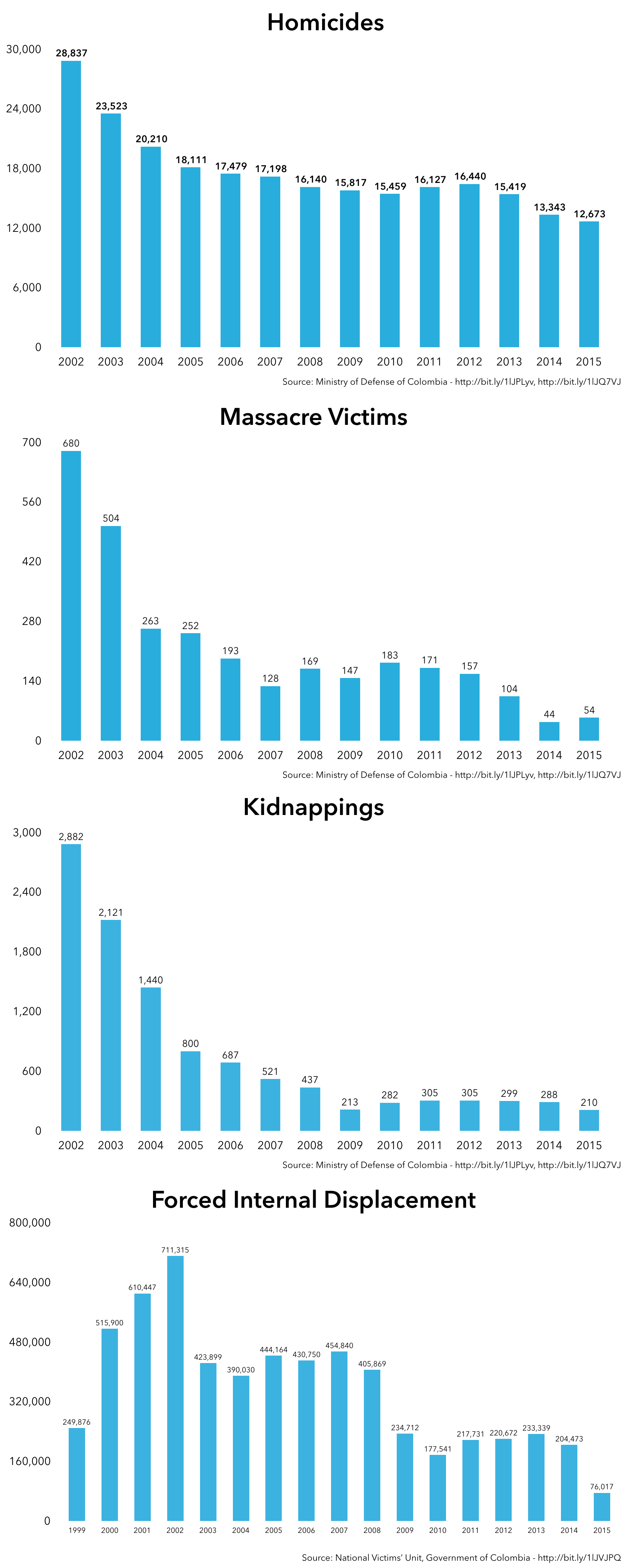Notable Improvements
In 2002, as Plan Colombia was getting underway and peace talks with the FARC collapsed, Colombians elected a new president, Álvaro Uribe (2002-2010), who promised to intensify the military’s operations against guerrillas. To a degree that few observers foresaw, Uribe’s U.S.-supported “Democratic Security” strategy won important gains in several key measures of security, especially in its initial years. These security gains made Uribe very popular among Colombians who, for instance, were now once again able to travel the country’s road network with little fear of being kidnapped. The country’s international image improved, and foreign investment increased.
The rapidity of the drops in homicides, kidnappings, and several other measures is difficult to explain, especially since it was followed by several years of plateaus or, at best, far more modest improvements. (From 2002 to 2005, homicides fell by 37 percent, but over the next 8 years, they fell by only 15 percent. From 2002 to 2009 kidnappings fell by 92 percent, but stayed the same ever since.)
Below these charts, some likely causes for these security improvements.

Some likely causes for these security improvements include:
- Improved mobility, in significant part thanks to U.S.-donated helicopters, which allowed Colombian forces to respond more quickly to guerrilla attacks and kidnappings.
- Broader deployments of military and police personnel throughout more of the national territory, along with strategic changes that placed these personnel out of their bases, which deterred attacks along main roads and in populated areas.
- The FARC turning out to be weaker than expected. The 2003-2004 removal of FARC fronts from Bogotá’s immediate surroundings and eastern Antioquia occurred far more quickly than any foresaw. The restoration (or inauguration) of police stations in remote municipalities took place with less guerrilla resistance than expected.
- Better and smarter police coverage, especially in cities, reduced homicides, the majority of which were never conflict-related to begin with.
- Paramilitary groups choosing, in 2002-03, to stop their territorial advance, which until then had suffered little opposition from the security forces, and instead to consolidate their political and economic influence in the territories they controlled, while their leaders negotiated demobilization terms with the Uribe government.
In 2008, the initial Plan Colombia and Democratic Security strategies arguably hit their high-water mark. Raids and military pressure killed top FARC leaders for the first time. Individual desertions of guerrilla fighters hit a record that has not been broken. And in July of that year, a military ruse fooled the FARC into releasing 15 of its highest-profile hostages without firing a shot.
Progress slowed after that. The FARC’s so-called “Rebirth Plan” brought an increase in attacks, though generally in more remote areas than before. New so-called “Criminal Bands (BACRIM),” led by former mid-level paramilitary leaders, competed for control of criminal income, increasing violent crime rates in several regions, including Medellín, Colombia’s second-largest city. Colombia did not measure important reductions in homicides and “acts of terrorism” (described in the next panel) until the past two years or so.
 15
15